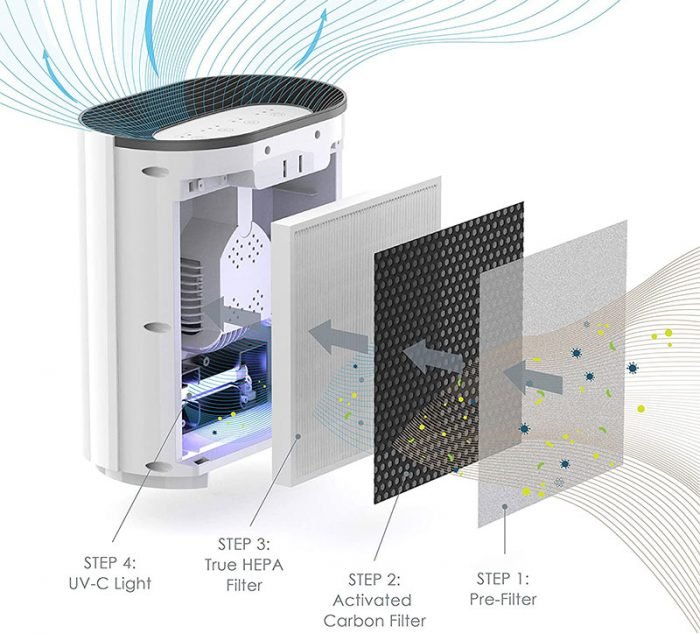When buying a dehumidifier, you may hear the words “HEPA filter”.
Understanding its definition and working mode can help you understand how the HEPA filter in the dehumidifier works.
Let’s enjoy.
What Is HEPA Filter?
HEPA (High-efficiency particulate air) filter, can theoretically remove at least 99.97% of dust, pollen, mold, bacteria, and any air particles as small as 0.3 microns (Micron is 1/1000000 meters, which is the way to measure particles, 0.3 microns equal to about 1/200 of the diameter of a hair).
0.3-micron air particles correspond to the worst air conditions!
MPPS stands for the Most Penetrating Particle Size, indicating that the device can capture larger or smaller particles more efficiently.
The characteristic of HEPA filter is that air can pass through, but small particles can not.
It is the PM2.5 killer, used in areas where the air environment is not good, can maximize the protection of users’ respiratory health.
Tips: Probably you also heard the “true HEPA filter”. As a true HEPA filter, it must certify to remove 99.99% of tiny particles as small as 0.3 microns, which is the smallest particle size to enter the lungs.
TRUE HEPA Filter
Advantages:
1. Efficient, capture most of the toxic pollutants.
2. The captured particles will be left in the air filter.
3. Physical air filters do not release ozone that causes asthma and other respiratory problems.
Shortcoming:
1. Need to change the filter regularly to maintain efficiency.
2. Can’t get rid of odors.
| Particles | Size(µm) | Particles | Size(µm) |
|---|---|---|---|
| Atmospheric | 0.001~40 | Grain Dust | 5~1,000 |
| Bacteria | 0.3~60 | Household Dust | 0.05~100 |
| Sand Granule | 100~10,000 | Human Hair | 40~300 |
| Burning Wood | 0.2~3 | Insecticide Dust | 0.5~10 |
| Cement Dust | 3~100 | Lead Dust | 0.1~0.7 |
| Clay | 0.5~1 | Mold Spore | 10~30 |
| Coal Powder | 1~100 | Pet Damdruff | 0.5~100 |
| Combustion Powder | 0.01~1 | Pollen | 10~1,000 |
| Dust Mite | 100~300 | Tobacco Smoke | 0.01~4 |
| Fly Ash | 1~1,000 | Virus | 0.005~0.3 |
Common Particles Size
Where Does HEPA Filter Come From?
HEPA filters were originally secretly developed by the US military for chemical, biological, and radiation defense purposes.
After World War II, the United States Atomic Energy Commission (AEC) chose to use the military’s AEC filter as the main particulate removal equipment for all exhaust gas systems in nuclear facilities.
Tips: the HEPA filter originally used in the Manhattan Project (Manhattan Project) to prevent the spread of radioactive pollutants in the air and commercialized in the 1950s.
How Does the HEPA Filter Works?
Today, most HEPA filters are made of staggered fiberglass mixtures.
There are 4 ways to capture particulate matter:
1. Direct impact: large particles move in a straight line, collide with each other, and then be captured.
2. Intercept: particles collide with the fiber and attach to the fiber.
3. Diffusion: as small particles travel, they collide with fibers and are captured.
4. Screening: this method is used when the particles are too large to insert into the space of the fiber.
How HEPA Filter Works
Changes in HEPA Filtering
HEPA filters can take many forms, using different parameters, such as grades, categories, or MERV ratings.
The U.S. Department of Energy (DOE) has set some standards for this, but the type of HEPA filter may vary from different suppliers.
According to its different filtering efficiency for PM 2.5 and PM10, HEPA filters can be divided into different HEPA levels.
The criterion for determining this parameter is based on the performance of the filter
when it’s the most difficult to cope with or the most easily penetrated particle size (MPPS).
This classification system is based on letters and numbers, just like coarse filters and fine filters using EN classification.
The screens are divided into 8 categories, from E10 to U17, depending on the efficiency of the medium against MPPS (the most penetrating particle size) and the size of any defects or leaks introduced in the manufacture of the finished product.
The minimum efficiency reporting value (Short called MERV) rating indicates the ability of the filter to capture large particles of 0.3-10 microns.
The higher the MERV level, the more particles the filter can capture!
MERV values range from 1 (minimum filtering) to 20 (maximum filtering).
Levels 17 and above are used only in the most stringent hospital or cleanroom environments, so the standard for normal use is 1-16.
Please refer to the tables below for more information about particulate matter, MERV rating, etc.
| MERV Rating | Dust Removal Efficiency | Size(µm) | MERV Rating | Dust Removal Efficiency | Size(µm) |
|---|---|---|---|---|---|
| 20 | ≥99.999% | 0.1~0.2 | 10 | 50~55% | 1~3 |
| 19 | ≥99.99% | 0.1~0.2 | 9 | 40~45% | 1~3 |
| 18 | ≥99.97% | 0.1~0.2 | 8 | 30~35% | 3~10 |
| 17 | ≥99.97% | 0.3 | 7 | 25~30% | 3~10 |
| 16 | ≥99.95% | 0.3~1 | 6 | <20% | 3~10 |
| 15 | ≥95% | 0.3~1 | 5 | <20% | 3~10 |
| 14 | 90~95% | 0.3~1 | 4 | <20% | ≥10 |
| 13 | 89~90% | 0.3~1 | 3 | <20% | ≥10 |
| 12 | 70~75% | 1~3 | 2 | <20% | ≥10 |
| 11 | 60~65% | 1~3 | 1 | <20% | ≥10 |
MERV Rating Specification
| MERV Rating | Standard Pollutant |
|---|---|
| 17~20 | Certain virus in the air |
| 13~16 | Bacteria, tobacco smoke, cooking oil, most of smoke |
| 9~12 | All kinds of dust |
| 5~8 | Mold spore |
| 1~4 | Pollen, dust mite |
MERV Rating
| Efficient Energy Level | Filtration Efficiency |
|---|---|
| E10 | 85% |
| E11 | 95% |
| E12 | 99.5% |
| H13 | 99.97% |
| H14 | 99.975% |
| U15 | 99.9975% |
| U16 | 99.99975% |
| U17 | 99.9999% |
Efficient Energy Level
No matter what products, although they are of good quality when they just came out of the factory.
However, with the increase of using time, or under your improper operation, it is possible to cause equipment failure.
Therefore, we must pay attention to the daily maintenance of the products.
Next, let me tell you the:
Dehumidifier Filter Maintenance
Tips: HEPA filter is optional for the Dehumidifier, please consult your dehumidifier supplier, they will give you a satisfactory answer.
Filter Maintenance Method
The filter must clean regularly, which will keep the circulating air volume of the dehumidifier unblocked, meanwhile reducing the resistance and improving the dehumidification capacity of dehumidifier.
After removing the air filter, you can rinse with tap water, gently scrub with a softer brush, or use an electric vacuum cleaner.
If the filter doesn’t clean in a long time, inhaling too much dust will make the air not circulate. First, it will reduce the amount of dehumidification; Second, it will damage the compressor.
Remarks:
1. Don’t use hot water above 60 ℃ to avoid deformation of the filter.
2. Don’t expose the filter to the sun after cleaning, otherwise will damage surface of the filter.
3. Rinse clean and air-dry in a cool place.
Dehumidifier HEPA Filter
Dehumidifier Filter Clean
Regularly remove the dehumidifier filter for cleaning can effectively improve the dedusting effect of the dehumidifier and improve the ambient air quality.
When using your dehumidifier, the tightness of the room must be good and must close the windows, otherwise will reduce the dehumidification performance a lot. At the same time, will reduce the lifetime of dehumidifier.
When the user adjusts the set humidity of the dehumidifier, you should set the comfort of the human body according to his own requirements for humidity, the size of the space, and other actual conditions.
Usually set humidity in the state of less activity, such as rest, sleep, etc., the relative humidity of the room is about 60%RH, and the human body will feel more comfortable.
If the humidity setting in the room is too low, in addition to making people feel dry, due to the great difference between indoor and external humidity and rapid expansion of moisture, the compressor will start and stop frequently, shortening the service life of the dehumidifier and consumes more energy.
Tips: Generally, regularly remove the filter of the dehumidifier for washing and scouring in 1-2 months, which can effectively improve the dedusting effect of the dehumidifier and improve the ambient air quality.
Regular cleaning heat exchangers of the unit can effectively improve the heat transfer coefficient and heat transfer efficiency, meanwhile, improving the dehumidifier working efficiency.
Conclusion
In summary, we believe you will have a brief understanding of HEPA filter dehumidifier, also the cleaning and maintenance tips of the filter.
Everyone should choose carefully and give themselves and their families a healthy and warm living environment.
Any comments?
Welcome leave a message or repost.











